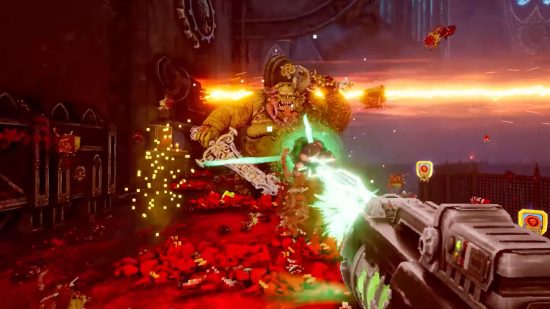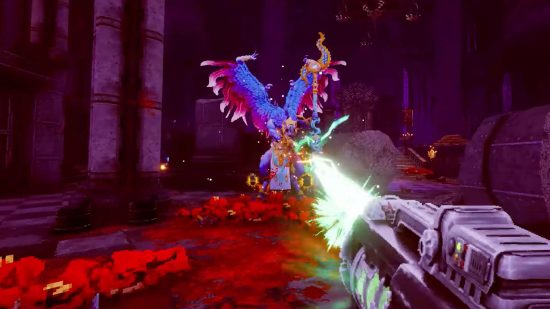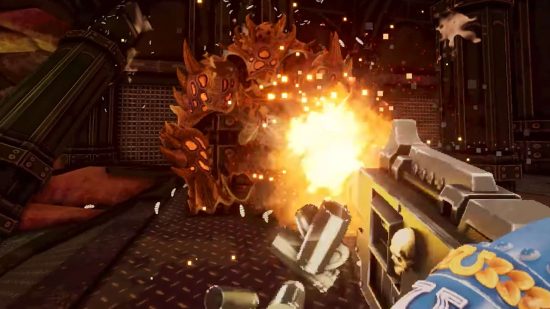Warhammer 40k Boltgun is an upcoming ‘boomer shooter’ from developer Auroch Digital, marrying the retro aesthetics of 90s FPS games with the other retro aesthetics of 90s Warhammer 40,000. Wargamer spoke to lead producer Anthony O’Neill, lead designer Grant Stewart, code lead Sam Chester, and audio lead Matt Walker, about the old-school inspirations behind their blast from the past.
“We saw the rise of the boomer shooter, we saw games like Dusk and Amid Evil and Ion Fury and stuff coming out… and every time we’d just be like: Oh, someone should really make a Warhammer one of these” code lead Sam Chester says. Eventually, the team decided that ‘someone’ should be Auroch – and now there’s only a month until Warhammer 40k Boltgun’s release date .
Lead designer Grant Stewart talks about the team’s love of retro Warhammer: “I’m really tempted to run downstairs and get all my 90s Exalted Flamers I’ve been painting. We’re all of an age basically where we got into [Warhammer 40k] the first time round in the 90s, in our early teens. That period of Warhammer holds a special place in our heart.”
Everyone in the team collects a Warhammer 40k faction. Stewart says “no one in the office will let me use my Adeptus Custodes anymore because they keep winning”. Producer Anthony O’Neill has a particularly deep cut: “It’s no longer canon, but the Sons of Malice, worshippers of the fifth Warhammer 40k Chaos god Malal”.
“There is something very special about 90s Warhammer”, Stewart says, but adds that the choice of setting for the game isn’t purely nostalgic: “It’s also particularly suited to a boomer shooter: it’s bright and colourful, and garish and violent and over the top”. The team also has a good relationship with Games Workshop, having adapted several retro Games Workshop board games into digital formats: Chainsaw Warrior, Fury of Dracula, and the tactical car combat game Dark Future.
‘Boomer shooter’ is a modern term describing the early 3D FPS games of the 90s, as well as contemporary games inspired by them. Each member of the Auroch team identifies a key quality that he loves about games in the genre.
O’Neill points to Unreal Tourament’s immediacy and accessibility: “There’s no barrier to entry there. It’s a really easy game to get in… You point your gun and you shoot at things and that’s kind of it really”.
Stewart says for him, it’s all about “guns and gore”. He explains: “I’ve played the original Doom often enough that I’ve had to force myself to uninstall it from all the devices I have it on so that I’ll play something else”.
He points to the “visceral immediate feedback” in Doom as a factor that makes the classic so compelling, and adds “it’s something we’ve concentrated on a lot in Boltgun… we have a lot of very cool Warhammer weapons to work with”, and great audiovisual feedback is essential to doing them justice.
Audio lead Matthew Walker seconds the importance of great sound feedback: “there’s some signature weapons, they absolutely had to slap it. I think we did a good job on those, notably the Bolter and the shotgun”.
Though he’s worked mostly on the games score and audio effects, Walker actually points to the “state of flow that you can enter” as core to the appeal of boomer shooters. He thinks the team has achieved that with Boltgun: “You pop one thing off, you hone in on something else with a Chainsword attack, you charge something else, you chain these things together, and you enter this kind of conveyor belt of abilities – and it’s great”. You can check out Wargamer’s Warhammer 40k Boltgun preview to see if we agree with him.

Code lead Chester says that the age of the genre has solved many design problems: “You have a game where you’re progressing through a level, getting keys, killing enemies, and then getting to the exit”. He sees that as a strength rather than a weakness, a starting point from which developers can experiment: “The format is so well established, but each game has its own twist on the format”.
This is the first part of our interview with Auroch; check back with Wargamer as there’s more to come!



